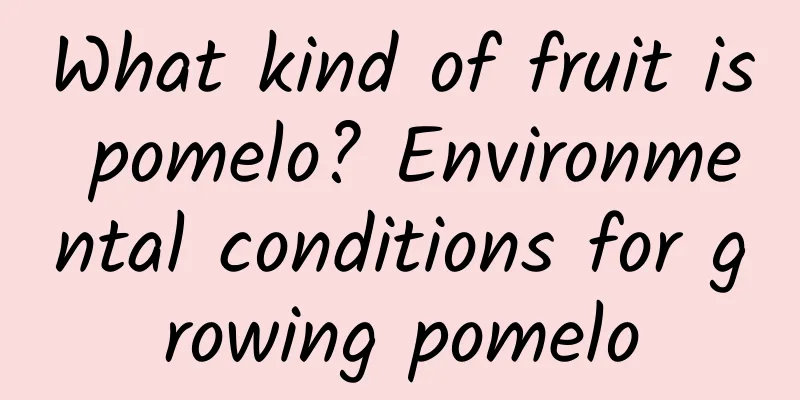What kind of fruit is pomelo? Environmental conditions for growing pomelo

|
The peel of pomelo is smooth and the color is more vivid. The essential oils in the peel can be used as a protective agent to prevent mosquito bites. The peel can remove the odor of the refrigerator. The skin, flowers and leaves can be used to extract high-quality essential oils, the fruit cortex can be used to extract high-quality pectin, and the pulp can be processed into fashionable drinks such as juice and milk. It is loved by consumers. Do you know what the environmental conditions for growing pomelo are? If you are interested, you can learn more. Contents of this article 1. What kind of fruit is pomelo 2. Environmental conditions for growing pomelo 3. When does pomelo mature? 1What kind of fruit is pomeloName: Pomelo Origin: Yuhuan, Taizhou, Zhejiang Other name: Yuhuan pomelo Season: Beginning of Autumn Characteristics: The meat is tender and crisp, juicy, rich and fragrant, sweet and sour, and of excellent quality. Ingredients: Rich in carbohydrates, organic acids, vitamins A, B, C and a variety of trace elements and amino acids. Benefits: Eating Yuhuan pomelo regularly can regulate qi and resolve phlegm, moisten the spleen and clear the intestines, relieve bad breath, and detoxify alcohol. It has a good effect on high blood pressure, diabetes, anorexia, bland mouth, indigestion and other diseases. The limonin extracted from the fruit has anti-cancer and anti-cancer effects. The fragrance can repel cockroaches when left indoors for a long time. The essential oils rich in the peel can be used as a protective agent to prevent mosquito bites. The peel can remove odors from the refrigerator. High-quality essential oils can be extracted from the epidermis, flowers and leaves, high-quality pectin can be extracted from the fruit cortex, and the pulp can be processed into fashionable drinks such as juice and milk. 2Environmental conditions for growing pomelo1. Cultivation environment Wenqie pomelo likes high temperature but is not cold-resistant. It grows best at 27-32℃. The best place to cultivate is a south-facing or southeast-facing slope with plenty of sunlight. Be careful to avoid winter cold winds and summer and autumn typhoons. Wenqie pomelo can be cultivated in all kinds of soil, but shallow and poor sandy land can bear fruit early, but the yield is low; in deep, fertile clay soil, it takes longer to bear fruit, the yield is high, the fruit skin is thick, and the flavor is poor; deep soil, good drainage, and rich in organic matter are the most ideal. Soil reaction is more suitable for slightly acidic to neutral. Soil with too strong acidity should be improved with lime or dolomite powder; alkaline soil will cause physiological disorders and is not easy to improve, so it is not suitable for Wenqie cultivation. When the groundwater level is too high and the drainage is poor, the roots are prone to rot and cause diseases, which is also not suitable for cultivation. During the typhoon and rainy season, attention should be paid to drainage. If drought occurs in the early stage of plant development and fruit growth, irrigation is required. Surface irrigation can be used for flat land, sprinkler irrigation is suitable for sloping land, and drip irrigation is used when water is insufficient. Grass cultivation is implemented, that is, low grasses are allowed to grow naturally on the soil surface or excellent grass species such as bahia grass are artificially planted to form a cover. It can avoid soil erosion. Mowing and covering in hot and dry seasons can also reduce water evaporation and regulate ground temperature. The decomposition of the cut grass and underground grass roots can also increase soil organic matter, which is extremely beneficial to the growth of fruit trees. It is a labor-saving and high-efficiency orchard management method. 2. Seedling propagation and selection Wendan can use two-year-old bitter pomelo or sour pomelo seedlings as rootstocks and carry out grafting propagation around the beginning of spring. It can also be propagated by high-pressure propagation in March and April, that is, peel the lower end of the branch in a ring shape for about 3 cm, treat it with 200 mg/L of naphthacetic acid (NAA) or indolebutyric acid (IBA), and wrap it with wet sphagnum moss or clay loam mixed with mature compost in a transparent plastic sheet, add water to keep the temperature, and after a period of time, roots will grow from the upper end of the peeling. After half a year, the root group will develop vigorously, and the cut will be transplanted in the seedbed, and then planted in 3 months or early spring of the following year. Seedlings propagated by high-pressure method have more fine roots and are more mature, so they can reach the fruiting age earlier after planting. 3. Cultivation management It is best to plant pomelo before budding from November to February of the following year. The planting method is a regular triangle to make full use of the space and even sunlight. The distance between rows and plants on flat land with fertile soil is 8-9 meters, and the tree shape is smaller on barren slopes, 6-7 meters is enough. Before planting, the planting hole should be dug appropriately, with a width and depth of more than 1 meter. Put compound fertilizer or decomposed compost in the lower layer, add soil and mix it, and compact it appropriately. Then stand the seedlings on top, and then add soil to compact it. The planting depth should be shallower than in the nursery, and the roots should be slightly piled up around the base. Water should be irrigated to make the roots close to the soil, and cover with straw to keep it moist. If the seedlings shake, support pillars should be set to fix them. Yuhuan Wendan Planting 4. Pruning, thinning and bagging In the early stage of young pomelo trees, single-stem pruning is adopted. The branches at the base are cut off. 3-4 branches with even spacing, even distribution of orientation and good development are selected as main branches at a height of about 60-80 cm from the ground, so that they can evenly extend to all sides and form a good crown. In the first few years, all the flowers are removed to promote the development of the tree. It is allowed to bear fruit from the fourth year. The weight of the fruit pulls the branches downward, which can make the crown open and form a semicircle. Pruning after the crown is formed is to reduce the consumption of nutrients by useless branches, increase sunlight transmission, promote the differentiation of flower buds in the branches inside the crown, and improve the yield and quality of the fruit. Pruning is done once a year from November to December to cut off the staggered, whorled, overcrowded, and weak branches. In addition, when unbalanced growth branches and diseased and insect-infested branches are found, they should be cut off at any time. Deformed or diseased fruits should be picked at any time. If the fruits are too dense, they should be thinned out when they develop to the size of eggs and then bagged. Bagging can prevent damage by rust ticks and fruit flies and reduce the use of pesticides. At the same time, the humidity in the bag increases and some sunlight is filtered, which can make the pomelo skin smoother and the color more colorful and attractive, making it popular with consumers. 3When does pomelo mature?Different varieties of grapefruit mature at different times. Normally, grapefruit matures between October and November, while early-maturing varieties can be available in September and late-maturing varieties can be available as late as January or February of the following year. Originated from Yuhuan County, Zhejiang Province. It has strong growth potential, large fruit, single fruit weight of 1250~2000 grams, and the largest can reach more than 3500 grams. The flesh is crisp and tender, and has fragrance. It is seedless or has few seeds, and has excellent quality. The edible rate is 60-65%, and 100 ml of juice contains 0.8-1.0 grams of acid and 50-60 mg of vitamin C. The fruit matures from mid-October to early November. Wendan pomelo has two types: oblate cone and high cone. The former is high-yielding, but the fruit cracks more. The latter has a small central column and almost no fruit cracking. This variety has strong growth potential, good yield, large fruit, bright color, fragrance, seedless or few seeds, and excellent quality. |
>>: World Osteoporosis Day series of popular science: Early prevention of fractures
Recommend
What are the complications after pelvic lymph node dissection?
The pelvic cavity is an important bone tissue for...
Is a small cervix good or bad?
Nowadays, women's health has become an issue ...
What is baking makeup? What are the specific steps for baking makeup?
Try to choose a finer spray, which will have a be...
Can I eat chili peppers during my period?
Chili is a vegetable we are very familiar with an...
How to treat benign ovarian cysts?
Everyone should be familiar with ovarian cysts. T...
How to cook leeks and what are the ways to eat them? Can leeks and potatoes be eaten together?
Leeks contain a lot of nutrients such as fiber, v...
Why do women often hiccup?
Everyone has had the experience of hiccups in dai...
Why do we eat sauerkraut noodles at weddings? How to make delicious sauerkraut noodles
The throat noodles are a tradition in Shaanxi wit...
Popularization of health knowledge on gout prevention and treatment
Gout concept formula Now that living standards ar...
Is fasting required for infertility testing? Authoritative experts answer
After infertility occurs, people usually go to th...
Delayed menstruation with mild abdominal pain
The key to delayed menstruation is to consider tw...
Can I have sex if my period is delayed?
When women and men reach a certain age, they will...
What causes vaginal bleeding during bowel movements?
We know that women generally only experience vagi...
Picture of redness in the third month of pregnancy
I believe that every pregnant mother is anxious a...









